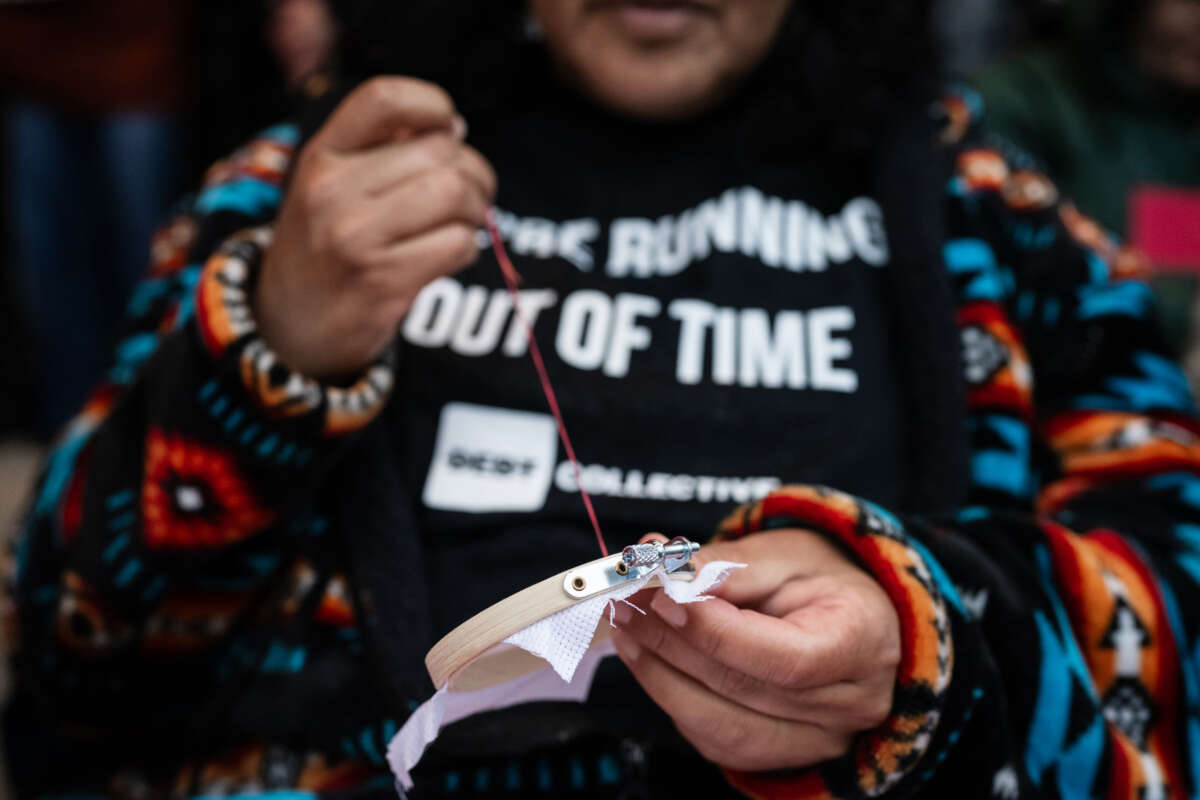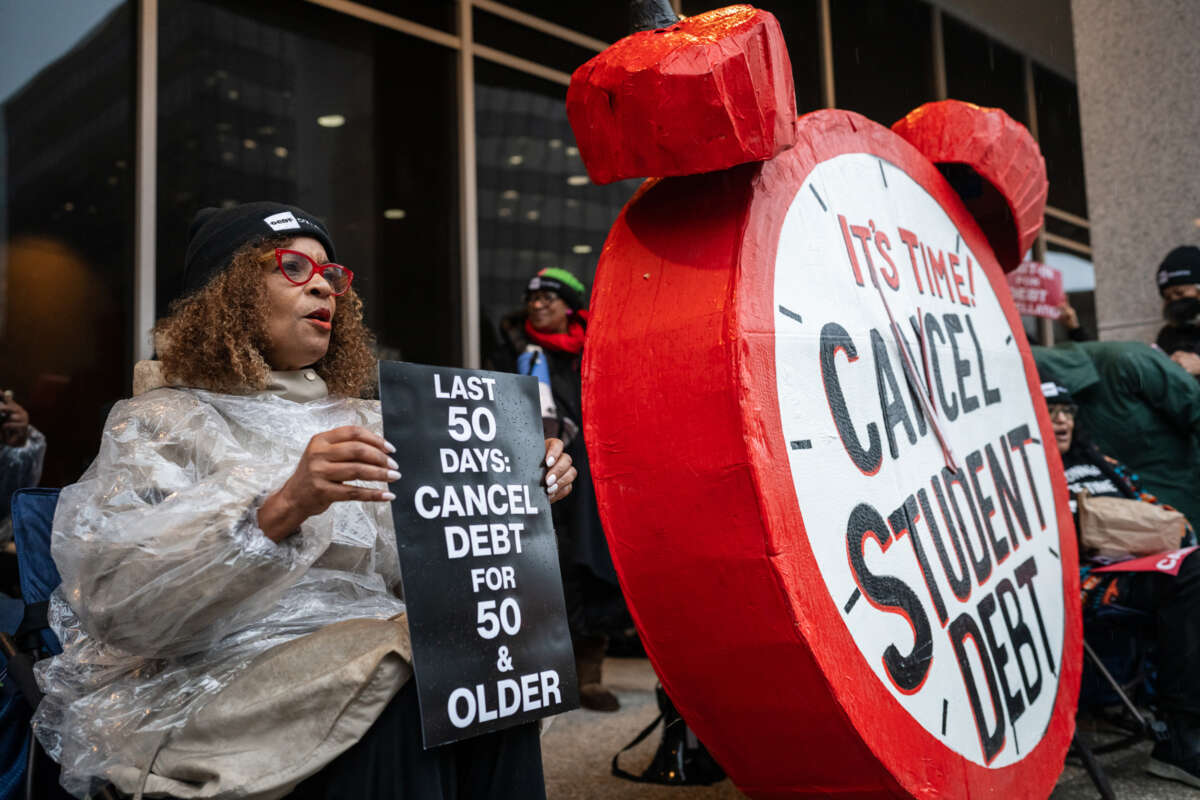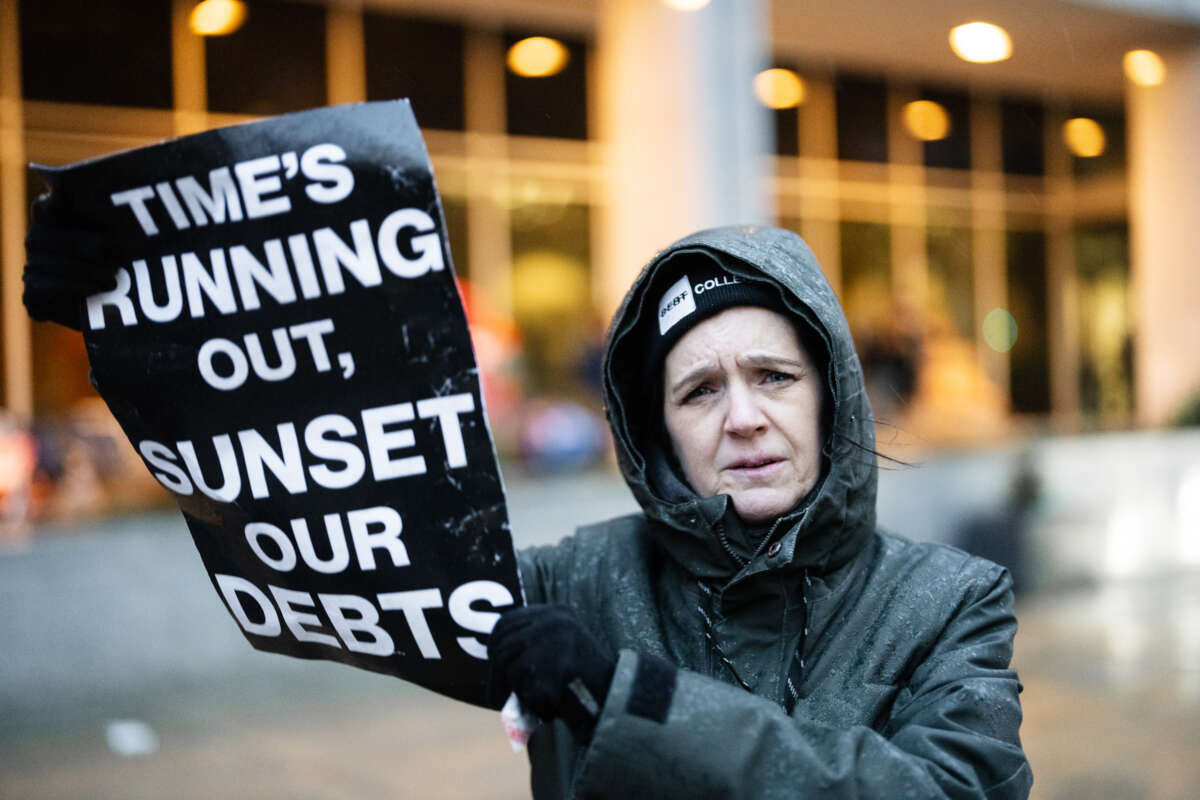Part of the Series
Communities Beyond Elections
Support justice-driven, accurate and transparent news — make a quick donation to Truthout today!
A group of student loan borrowers aged 50 and up traveled from around the country to Washington, D.C. on December 11, setting up rocking chairs outside the Department of Education. Dressed in ponchos and beanies to protect against the frigid rain, they passed out cross-stitch kits and signs reading, “Knit-In for Debt Cancellation,” sharing their personal debt stories amidst chants of “Biden, don’t forget, cancel student debt.” These protesters are all members of the Debt Collective, the first union of debtors in the country, and they came to Washington with a message for President Joe Biden: Cancel student debt for borrowers over 50 years old before Donald Trump takes office in January.
Mary Donahue is one of the Debt Collective members who joined the action. A former stay-at-home mom, Donahue decided to go to graduate school when her youngest child went to college. She has succeeded as a social worker in Richmond, Virginia, since she completed her degree in 2008. Donahue loves what she does, and describes the work as “life-saving.” Donahue has $145,000 of student loan debt from her master’s program and $125,000 of it, she says, is interest.
Donahue joined the Debt Collective a few years ago and was excited at the prospect of being in a debtors’ union with people who shared her struggle. “No one in this group had parents who were like, ‘here’s money to go to college,’” Donahue said. “We were all trying to improve our lives by getting an education.”

Becki Wells of Detroit, Michigan, bought savings bonds with her ex-husband to finance their children’s college education. They cashed them to invest the money in the stock market. When the stock market crashed in 2008, she lost the money, and had no choice but to go into debt to put her children through college. Wells shows pride in her children: her son graduated from Howard University and her daughter from Temple University. “We’re from the inner-city of Detroit,” she shared with the group when it was her turn to take the bullhorn. “And I still managed to raise two responsible, healthy, valued community members who are accomplished and productive tax-paying citizens.” She owes over $230,000.
People in the U.S. owe a total of $1.75 trillion in federal and private student loan debt combined, across about 42.8 million federal borrowers and an estimated 3 million private borrowers. Behind those numbers is a group of people ripe for organizing. The Debt Collective has created a political constituency around debt relief. And when it comes to student loan debt, their cause has become particularly popular — a Data for Progress poll from September 2024 found that 69 percent of voters under 45 said Biden should “continue fighting to cancel student loan debt.”
But the cause cuts across age lines. While student debt is often framed as an issue that primarily affects young people, the reality is that many middle-aged and senior Americans are facing the reality of crushing student debt that has followed them throughout their entire lives. Their student debt complicates their ability to retire, support their children or elderly parents, and access housing and medical care. Older adults are the fastest growing group of people experiencing homelessness.
In 2022, 3.5 million Americans over the age of 60 had a total of $1.25 billion in student loan debt. Some of these people are still paying off their own student loans, and others are paying off loans from putting children or other family members through college.

The burden of debt is more than just financial: there’s the shame and stigma of having student debt, especially as a senior. Organizing provides community and relief. As Jason Wozniak, an organizer and researcher with the Debt Collective, said during the action, “Alone, our debt is a burden. Together, it’s our collective power.” The Debt Collective is organizing to make that collective power tangible: The financial power of peoples’ collective debts can be leveraged to take on debt-based systems like housing, education, carceral and medical debt.
While student debt is a uniting issue, not everyone is equally impacted. People of color are disproportionately burdened by student debt because of many deeply rooted structural factors, including lower wages, inequities in wealth accumulation and generational wealth. These disadvantages often compound across generations.
Sophia Marjanovic joined the action from Phoenix, Arizona. She is an enrolled member of the Oceti Sakowin, or Sioux, tribe. According to the 1868 Fort Laramie Treaty, the United States government is obligated to provide free education for members of the tribe in exchange for their land. It has not. As a result, Marjanovic has thousands of dollars of debt from her education that has left her unable to find consistent housing and vulnerable to unsafe housing conditions.
The administration could cancel this debt right now. Section 902.2 of the Federal Claims Collection Standard Act permits the Department of Education to discharge loans held by older borrowers, based on age and likelihood to pay the debt back within their lifetime. President Biden has one last chance to cancel this debt and make good on a campaign promise that played a pivotal role in his election in 2020. On the campaign trail, President Biden pledged at least $10,000 in student debt relief for borrowers making less than $125,000 a year. The administration attempted to make good on this promise, but the Supreme Court shut down his program in June of 2023. Ultimately, through targeted programs instead of a universal effort, the administration did deliver significant student loan debt relief — almost $175 billion to 4.8 million borrowers. Yet that leaves over 35 million borrowers without any debt relief, including many of the folks who joined the action outside the Department of Education. In these final months of his presidency, the protesters conveyed, he has the moral obligation to do right where he still can by cancelling debt for the millions of Americans suffering under its crushing weight.
The election was front of mind for many of the participants in the action. Marjanovic spent the months before November knocking doors for the Democrats in Arizona, and has spent years before then helping elect Democrats in the state. She said that as “someone who’s brown, I took a risk knocking doors looking for swing voters in many of the neighborhoods [I went to]. … It upsets me because there’s so many people suffering in this country. That’s what I felt doing that door-knocking.” Marjanovic is convinced that Democrats lost because they are “too afraid to stand up for the people.”
Already vulnerable, many older debtors are extremely anxious about what a second Trump administration will mean for them. Tricia Louise Keffer is 52 years old and came up to Washington, D.C. from Niceville, Florida, for the action. She is $200,000 in debt for a master’s program in landscape architecture with a stated price of $35,000. She said that President Biden’s refusal to follow through with his campaign promise to cancel debt felt like being “thrown out in the cold, into a freezing iceberg of death. … We don’t know what’s going to happen with the next administration. Am I going to be thrown into a debtors’ prison?”
Many of the debtors at the action want their reality to be a warning for younger people with student debt. “I had no idea how the compounded interest works … so the longer we have [the debt], the bigger it gets,” said Donahue. “When I graduated, I had $70,000 … [where I am now] is where people in their 30s are going to be.”
The message for President Biden is clear: cancel debt now, with the time left, and show the American people that the Democratic Party can prioritize helping working people. “How many billions of dollars have been sent to other countries for bombs, when people in this country are suffering,” Donahue asked. She has spent her career in public service, but she came to D.C. to ask President Biden to give her a lifeboat: “I’m here to try and save my life.”
Media that fights fascism
Truthout is funded almost entirely by readers — that’s why we can speak truth to power and cut against the mainstream narrative. But independent journalists at Truthout face mounting political repression under Trump.
We rely on your support to survive McCarthyist censorship. Please make a tax-deductible one-time or monthly donation.
